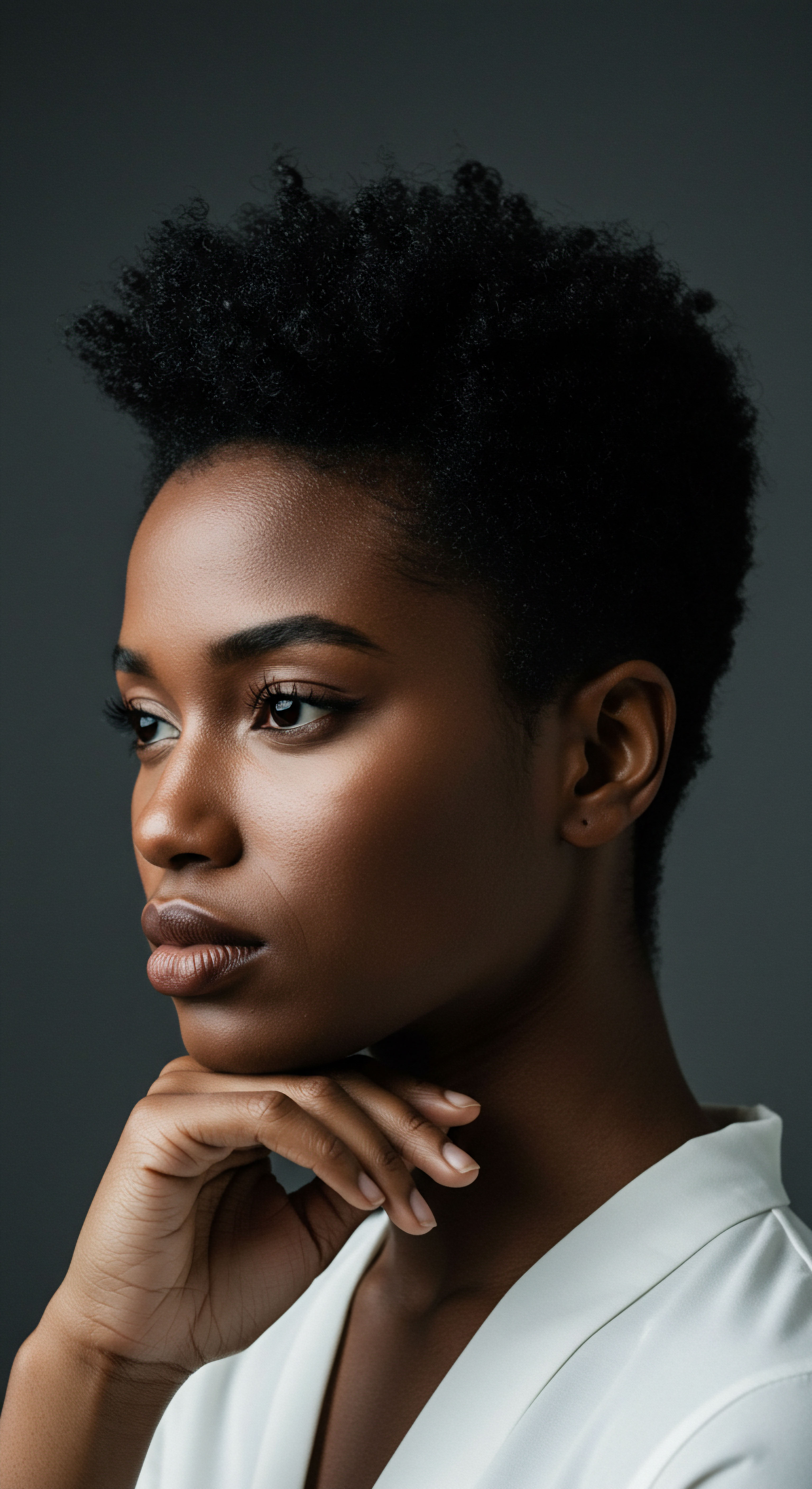
Roots
The quiet moments of slumber, often perceived as a mere pause in our bustling lives, hold a profound, often unseen, influence over the delicate dance of our hair’s vitality. Many of us have observed, perhaps without fully comprehending, how periods of unrest can leave our strands feeling lackluster, lacking their usual vibrancy. This gentle inquiry into sleep quality and its relationship with hair growth patterns beckons us to consider the foundational rhythms that orchestrate life within our very being, extending to the very follicles that cradle our textured hair. Our exploration begins at this elemental level, tracing the subtle, yet powerful, connections that bind our nightly repose to the flourishing crown we wear each day.
Within the serene expanse of night, while the world quiets, our bodies undertake a remarkable series of restorative processes. This period of deep physiological regeneration is not a passive state but a time of active repair and renewal, a fundamental truth that shapes everything from our cellular health to the outward manifestation of our well-being. For textured hair, with its unique structure and inherent needs, these nightly operations are particularly significant. The foundation of strong, resilient strands is laid during these hours, far from the conscious thought of daily styling or conditioning.

The Hair’s Own Rhythmic Cycle
Every strand of hair on our heads follows a meticulously choreographed life cycle, a pattern of growth, transition, and rest. This cycle, a testament to the body’s enduring capacity for renewal, unfolds within each individual hair follicle. The primary phase, known as Anagen, represents active growth, a period where cells within the follicle divide rapidly, pushing forth a new hair shaft. This phase can last for years, determining the potential length of our hair.
Following this, a brief transitional stage, Catagen, signals the end of active growth, as the follicle begins to shrink. Lastly, the Telogen phase marks a period of rest, where the hair ceases growth and eventually sheds, making way for a new anagen cycle to begin.
This rhythmic progression is not isolated from the broader biological rhythms of our existence. Our internal clocks, those intricate systems that regulate daily cycles of activity and rest, play a quiet but persistent role in guiding the hair’s own journey. The hair follicle itself harbors components of a circadian clock, a localized timekeeper that influences the timing of cellular events within its structure. This internal rhythm suggests a deep biological connection between our overall sleep-wake patterns and the precise choreography of hair growth.
The body’s nightly repair work extends to each hair follicle, quietly shaping the future of our strands.

Hormonal Orchestration During Rest
The quality of our sleep directly influences the delicate balance of hormones that govern countless bodily functions, including those pertinent to hair growth. During deep sleep stages, the body releases a cascade of essential hormones that act as messengers, guiding cellular repair and regeneration. For instance, Growth Hormone, a potent agent of tissue repair and cellular proliferation, sees its most significant release during these profound periods of rest. Its presence supports the active, growth-oriented anagen phase of hair follicles, contributing to the strength and vitality of emerging strands.
Beyond growth hormone, another key player in the nightly symphony is Melatonin. Often recognized for its role in regulating our sleep-wake cycle, melatonin also exhibits a quiet influence within the hair follicle itself. Research suggests that melatonin receptors exist within these follicular structures, hinting at its capacity to synchronize the hair cycle and perhaps prolong the active growth phase. When our sleep is disrupted, the harmonious release of these hormones can waver, potentially impacting the natural progression of the hair’s life cycle.
| Hair Growth Phase Anagen (Growth) |
| Description Active cellular division and hair shaft production. Longest phase. |
| Sleep's Potential Role Supported by optimal growth hormone and melatonin release during deep sleep. |
| Hair Growth Phase Catagen (Transition) |
| Description Brief, regressive phase where growth ceases and follicle shrinks. |
| Sleep's Potential Role Disrupted sleep may hasten entry into this phase. |
| Hair Growth Phase Telogen (Resting/Shedding) |
| Description Hair rests, then sheds as new hair begins below. |
| Sleep's Potential Role Poor sleep, particularly chronic, can push more follicles into this phase prematurely. |
| Hair Growth Phase A well-regulated sleep cycle helps maintain the balance of these phases, promoting healthy, continuous hair growth. |

Ritual
As we step from the foundational understanding of sleep’s biological influence into the realm of daily practices, we recognize that our approach to nightly rest holds practical wisdom for the vitality of our textured hair. The daily rhythms we establish, the conscious choices we make before our heads meet the pillow, contribute to a quiet ritual that can either support or hinder the flourishing of our strands. This section offers guidance, a gentle hand extended to explore the ways our sleep practices intertwine with the ongoing care and radiance of our hair, moving beyond abstract science to the tangible aspects of our lives.
Consider the myriad stressors of modern living ❉ the glow of screens late into the night, the persistent hum of responsibilities, the often-unseen pressures that accumulate within our minds and bodies. These daily realities can subtly erode the quality of our sleep, and in turn, ripple through our physiological systems, reaching even the delicate processes of hair growth. Our hair, a sensitive barometer of our internal state, often mirrors the disquiet within. Addressing sleep quality, then, becomes an active, nurturing practice, a ritual of self-care that extends far beyond mere cosmetic concern.

How Does Stress from Sleep Deprivation Affect Hair?
One of the most direct pathways through which poor sleep impacts hair vitality is its influence on the body’s stress response. When sleep is consistently insufficient or fragmented, our bodies interpret this as a form of stress, prompting an elevated production of stress hormones, particularly Cortisol. While cortisol serves a vital role in short-term stress management, chronically elevated levels can become a silent antagonist to healthy hair growth.
High cortisol levels can disrupt the natural hair growth cycle, potentially shortening the active anagen phase and pushing a greater number of hair follicles into the resting, or telogen, phase prematurely. This shift can lead to increased hair shedding, a condition known as Telogen Effluvium, where hair loss appears diffuse and widespread. For individuals with textured hair, who often experience slower growth rates and may already be prone to breakage, this acceleration of the shedding phase can be particularly noticeable and disheartening.
- Elevated Cortisol ❉ Persistent sleep disruption triggers a rise in this stress hormone.
- Hair Cycle Disruption ❉ High cortisol can prematurely usher hair follicles into a resting state.
- Increased Shedding ❉ This often results in a temporary but noticeable increase in hair fall.

Can Nightly Hair Protection Make a Difference?
Beyond the internal biological shifts, the physical environment of our sleep also plays a role in preserving the integrity of textured hair. Nighttime rituals, particularly those involving protective styling and appropriate head coverings, can mitigate external stressors that contribute to breakage and dryness. The friction between hair strands and abrasive pillowcases, for instance, can lead to mechanical damage, tangles, and frizz, diminishing the appearance and feel of healthy hair.
The tradition of wrapping hair or wearing bonnets, deeply rooted in many textured hair care practices, gains a renewed significance when viewed through the lens of sleep quality. A silk or satin bonnet, for example, provides a smooth, low-friction surface that safeguards delicate strands from the rigors of tossing and turning. This simple act helps to retain moisture, minimize tangling, and preserve styling, allowing the hair to rest undisturbed while the body engages in its restorative processes. Such practices honor the hair’s need for a peaceful, protected environment during its nightly rejuvenation.
Gentle nightly rituals provide a sanctuary for textured strands, safeguarding their delicate balance.

Creating a Sleep Sanctuary for Your Strands
Cultivating a restful sleep environment and consistent sleep patterns are not just for overall well-being; they are also a quiet investment in the health of your hair. This extends to setting a regular bedtime and wake-up time, even on weekends, to help regulate your body’s natural circadian rhythms. Dimming lights, avoiding stimulating activities before bed, and creating a cool, dark, quiet sleep space all contribute to deeper, more restorative sleep cycles.
Consider incorporating calming pre-sleep activities into your routine. A warm bath, a few moments of gentle stretching, or reading a comforting book can signal to your body that it is time to unwind. For your hair, this might involve a light oiling of the scalp, a gentle detangling with fingers or a wide-tooth comb, and then securing it in a loose, protective style. These conscious actions, woven into the fabric of your evenings, help to establish a serene transition from day to night, supporting both your internal equilibrium and the external vibrancy of your hair.

Relay
Stepping into the deeper currents of this inquiry, we arrive at a space where the science of sleep and the very patterns of hair growth intersect with remarkable precision. This is where we move beyond surface-level observations to consider the intricate interplay of biological timekeepers, cellular responses, and the profound impact of our internal environment on the very structure and behavior of our strands. Our exploration here seeks to unravel the less apparent complexities, drawing from research that casts new light on the subtle yet powerful dialogues occurring within our bodies as we rest.
The notion that sleep merely rests the mind and body undersells its profound biological role. It is a period of highly regulated activity, a finely tuned orchestration of cellular repair, hormonal regulation, and metabolic adjustments. For hair, an organ that regenerates continuously throughout life, this nightly orchestration is particularly significant. We can perceive the hair follicle not just as a site of growth, but as a miniature biological clock, responding to and influenced by the broader rhythms of our existence.

Does Our Internal Clock Shape Hair Cycles?
Emerging research reveals that hair follicles possess their own intrinsic circadian clock, a localized timekeeping mechanism that influences the timing of growth and repair processes within the follicle itself. This discovery suggests a fascinating layer of control, where the hair’s regenerative capacity is, in part, synchronized with our body’s overarching day-night cycle. The interplay between the central circadian pacemaker in the brain and these peripheral clocks in tissues like the skin and hair follicles is a subject of active scientific inquiry.
Consider the intriguing findings from a study conducted at the Salk Institute for Biological Studies. Researchers there, exploring the effects of radiation therapy on hair, made a compelling observation in mice. They found that mice lost a staggering 85 percent of their hair if they received radiation therapy in the morning, yet only experienced a 17 percent loss when the same treatment was administered in the evening. This stark difference was attributed to the discovery that mouse hair cells primarily engage in DNA repair during the evening hours.
This process is akin to a meticulous nightly cleanup, allowing cells to mend damage accumulated throughout the day. When radiation, a potent source of DNA damage, was delivered in the morning, the hair cells had to endure a full day before their repair mechanisms were fully active, leading to significant loss. Conversely, evening treatment coincided with the peak of their repair activity, allowing for rapid healing and minimal damage.
The hair follicle’s own internal clock aligns its repair efforts with the quietude of night.
While this specific study was conducted on mice and focused on external damage, it highlights a profound principle ❉ the timing of biological processes, influenced by circadian rhythms, holds substantial sway over cellular resilience and regenerative capacity. For human hair, particularly textured hair with its delicate structure and susceptibility to environmental factors, this insight underscores the deep connection between consistent, quality sleep and the hair follicle’s ability to maintain its growth cycle and recover from daily stressors. A disrupted sleep schedule could mean that hair cells miss their optimal window for repair, potentially impacting long-term health and growth patterns.

How Hormonal Balance Impacts Hair Health
The endocrine system, a network of glands that produce and release hormones, operates in close concert with our sleep patterns. Disruptions in sleep can lead to imbalances in hormones that directly influence hair growth. For example, consistent lack of sleep can lead to a sustained elevation of Cortisol, the body’s primary stress hormone. Beyond its role in pushing hair into a resting phase, chronic cortisol can also influence the micro-environment of the scalp, potentially affecting nutrient delivery to the follicles.
Conversely, the hormone Melatonin, widely recognized for its sleep-regulating properties, also holds a quiet but significant role in hair biology. It is produced by the pineal gland, with levels naturally rising in darkness to signal the body’s readiness for sleep. However, melatonin receptors have been identified within human hair follicles, suggesting a direct role in hair cycle regulation.
Some studies have explored topical melatonin as a potential aid for certain forms of hair thinning, particularly in women, hinting at its capacity to stimulate hair growth and prolong the anagen phase. This dual function of melatonin—orchestrating sleep and influencing hair vitality—underscores the profound interconnectedness of our bodily systems.
| Hormone Cortisol |
| Primary Role in Body Stress response, metabolism regulation |
| Connection to Sleep & Hair Elevated by poor sleep; can disrupt hair cycle, leading to shedding. |
| Hormone Melatonin |
| Primary Role in Body Sleep-wake cycle regulation |
| Connection to Sleep & Hair Influenced by sleep quality; receptors in hair follicles suggest a role in growth cycle timing. |
| Hormone Growth Hormone |
| Primary Role in Body Cellular repair, tissue regeneration |
| Connection to Sleep & Hair Primarily released during deep sleep; supports hair follicle activity and anagen phase. |
| Hormone Maintaining a balanced hormonal landscape through quality sleep is a gentle yet powerful act for hair health. |

The Silent Link to Autoimmune Responses
The connection between sleep quality and hair growth extends into the complex realm of the immune system, particularly in conditions like Alopecia Areata. This autoimmune disorder, characterized by patchy hair loss, involves the immune system mistakenly attacking hair follicles. Research has consistently observed a bidirectional link between sleep disturbances and alopecia areata. Individuals with this condition often report impaired sleep quality and increased daytime fatigue, and conversely, those with sleep disorders appear to have a significantly greater potential for developing alopecia areata.
While the exact mechanisms remain an area of ongoing study, one prevailing theory suggests that prolonged sleep deprivation can lead to immune dysregulation, where the immune system’s delicate balance is disturbed. This can contribute to chronic inflammation throughout the body, which may then exacerbate autoimmune conditions such as alopecia areata. Furthermore, the psychological burden of living with hair loss can itself trigger anxiety and depression, creating a cyclical relationship where stress worsens sleep, and poor sleep potentially intensifies the autoimmune response, thereby affecting hair. This layered interaction speaks to the profound influence of sleep on our entire physiological landscape, including the quiet work of our hair follicles.
- Immune Dysregulation ❉ Extended periods of poor sleep can alter the immune system’s balance.
- Inflammation ❉ This imbalance may contribute to chronic inflammation, a factor in autoimmune conditions.
- Bidirectional Relationship ❉ Sleep disturbances can be linked to conditions like alopecia areata, and the condition itself can disrupt sleep.

Reflection
As our quiet exploration of sleep’s subtle yet profound influence on hair growth patterns draws to a close, we are left with a gentle realization ❉ the vibrant health of our textured strands is not merely a surface concern, but a living testament to the deeper rhythms and care we extend to our entire being. The connection between our nightly repose and the flourishing of our hair is not a simple cause-and-effect, but a beautiful, layered dance of biological harmony, environmental consideration, and personal well-being.
We have seen how the unseen world of cellular repair and hormonal orchestration during sleep shapes the very foundation of hair growth. We have considered the practical rituals of nightly care, acknowledging how simple acts of protection can offer profound support to our delicate strands. And we have delved into the deeper scientific currents, discovering the hair follicle’s own internal clock and the intricate interplay of stress, hormones, and immune responses.
This understanding invites us to approach our sleep, and by extension, our hair care, with a renewed sense of reverence and intention. It encourages us to listen to the quiet signals of our bodies, to honor the need for rest, and to recognize that true radiance springs from a place of deep, internal balance. May this knowledge serve as a gentle guide, inspiring a more mindful approach to the sacred act of sleep, allowing your textured hair to flourish in its fullest, most serene expression.

References
- Panda, S. Plikus, M. V. Chaix, A. et al. (2013). Circadian clock in mouse hair reveals period of time when damage from radiotherapy can be quickly repaired, keeping hair intact. Proceedings of the National Academy of Sciences.
- Fischer, T. W. Burmeister, G. Schmidt, H. W. & Elsner, P. (2004). Melatonin increases anagen hair rate in women with androgenetic alopecia or diffuse alopecia ❉ results of a pilot randomized controlled trial. British Journal of Dermatology, 150(2), 341-345.
- Fischer, T. W. Trüeb, R. M. Hänggi, G. Innocenti, M. & Elsner, P. (2012). Topical melatonin for treatment of androgenetic alopecia. International Journal of Trichology, 4(4), 236-245.
- Rebora, A. (2009). Telogen effluvium ❉ an update. Journal of Cosmetic Dermatology, 8(2), 114-119.
- Arck, P. C. Handjiski, B. Peters, E. M. J. et al. (2006). Stress and the hair follicle ❉ exploring the link. Dermatology and Therapy, 19(4), 253-261.
- Lin, H. Y. Chen, H. Y. Li, S. Y. et al. (2017). Sleep disorders and risk of alopecia areata ❉ A nationwide population-based cohort study. Journal of the American Academy of Dermatology, 76(4), 675-680.e1.
- Song, Y. J. Kim, S. J. Park, J. M. et al. (2020). Association between sleep quality and female pattern hair loss in women aged 30-40 years ❉ A cross-sectional study. Journal of Cosmetic Dermatology, 19(11), 3045-3051.
- Choi, S. Kim, Y. S. Shin, C. & Kim, J. H. (2022). Sleep quality in men with androgenetic alopecia. Sleep and Breathing, 26(3), 1055-1061.
- Xerfan, E. M. S. Andersen, M. L. Facina, A. S. Tufik, S. & Tomimori, J. (2021). The role of sleep in telogen effluvium and trichodynia ❉ A commentary in the context of the current pandemic. Journal of Cosmetic Dermatology, 20(4), 1088-1090.
- Chang, Y. H. Chang, S. Y. & Chen, H. C. (2014). Circadian rhythm disruption and hair loss ❉ A possible link. Journal of Dermatological Science, 75(2), 143-144.
- Slominski, A. T. Zmijewski, M. A. Semak, I. et al. (2012). Melatonin as a hair growth promoter ❉ The role of its receptors in the human hair follicle. Journal of Pineal Research, 52(3), 323-333.
- Oh, S. H. Park, J. H. Kim, J. H. & Kim, S. J. (2023). Clinical studies using topical melatonin. Cosmetics, 10(4), 115.
- Lin, K. K. Lin, C. Y. Huang, H. C. & Chen, H. C. (2023). Overview of the circadian clock in the hair follicle cycle. International Journal of Molecular Sciences, 24(13), 10940.
- Oh, S. H. & Kim, S. J. (2023). Melatonin and the human hair follicle. Journal of Drugs in Dermatology, 22(3), 296-301.